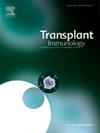通过激活诱导的标记物识别不同亚群的同种异体反应性T细胞
IF 1.4
4区 医学
Q4 IMMUNOLOGY
引用次数: 0
摘要
同种异体反应性t细胞可以通过激活诱导的标记物(AIMs)来观察,包括CD69、CD134、CD137和CD154。这些AIMs是否识别同种异体反应性t细胞的类似亚群在很大程度上是未知的。通过使用针对CCR7和CD45RA的抗体解剖不同的T细胞亚群,详细分析了表达aim的同种反应性CD4+ T细胞的表型。此外,通过使用多参数流式细胞术测定表达aim的CD4+ T细胞中细胞因子产生细胞的比例,进行了详细的功能分析。CD154主要由naïve和中央记忆性同种异体CD4+ T细胞表达,CD134主要由中央记忆性同种异体CD4+ T细胞表达,CD137主要由CD4+同种异体记忆性T细胞表达。同种异体反应性CD8+ T细胞只能被CD137的表达所识别。大多数同种反应性CD4+ T细胞为单一aim阳性(72%),所有AIMs的共表达并不常见。抗cd3 /抗cd28多克隆刺激导致CD4+ T细胞高频率共表达AIMs,这是一种剂量依赖性现象。表达>;1 AIM的同种反应性记忆CD4+ T细胞中多功能细胞比例最高。同种异体刺激分类naïve CD4+ T细胞产生增殖T细胞群,发展为表达>;1 AIM的效应记忆T细胞。综上所述,不同的AIMs由不同的循环同种异体CD4+ T细胞亚群优先表达,AIMs的表达受增殖/分化和T细胞受体(TCR)刺激强度的影响。本文章由计算机程序翻译,如有差异,请以英文原文为准。
Recognition of different subsets of alloreactive T cells by activation-induced markers
Alloreactive T-cells can be visualized using activation-induced markers (AIMs) including CD69, CD134, CD137 and CD154. Whether these AIMs recognize similar subsets of alloreactive T-cells is largely unknown. AIM-expressing alloreactive CD4+ T cells were analyzed in detail for phenotype by dissecting different T-cell subsets using antibodies directed to CCR7 and CD45RA. Moreover, detailed functional analysis was performed by determining proportions of cytokine producing cells within AIM-expressing CD4+ T cells using multiparameter flowcytometry. CD154 was predominantly expressed by naïve and central-memory alloreactive CD4+ T cells, CD134 by central-memory alloreactive CD4+ T cells and CD137 by CD4+ alloreactive memory T cells. Alloreactive CD8+ T cells could only be recognized by CD137 expression. The majority of alloreactive CD4+ T cells were single AIM-positive (72 %) and co-expression of all AIMs was infrequent. Polyclonal stimulation with anti-CD3/anti-CD28 resulted in a high frequency of CD4+ T cells co-expressing AIMs which was a dose-dependent phenomenon. Alloreactive memory CD4+ T cells expressing >1 AIM showed the highest proportion of polyfunctional cells. Allogeneic stimulation of sorted naïve CD4+ T cells yielded a population of proliferating T cells, progressing to effector-memory T cells expressing >1 AIM. In conclusion, different AIMs are preferentially expressed by different subsets of circulating alloreactive CD4+ T cells and expression of AIMs is determined by proliferation/differentiation and strength of the T cell receptor (TCR)-stimulation.
求助全文
通过发布文献求助,成功后即可免费获取论文全文。
去求助
来源期刊

Transplant immunology
医学-免疫学
CiteScore
2.10
自引率
13.30%
发文量
198
审稿时长
48 days
期刊介绍:
Transplant Immunology will publish up-to-date information on all aspects of the broad field it encompasses. The journal will be directed at (basic) scientists, tissue typers, transplant physicians and surgeons, and research and data on all immunological aspects of organ-, tissue- and (haematopoietic) stem cell transplantation are of potential interest to the readers of Transplant Immunology. Original papers, Review articles and Hypotheses will be considered for publication and submitted manuscripts will be rapidly peer-reviewed and published. They will be judged on the basis of scientific merit, originality, timeliness and quality.
 求助内容:
求助内容: 应助结果提醒方式:
应助结果提醒方式:


